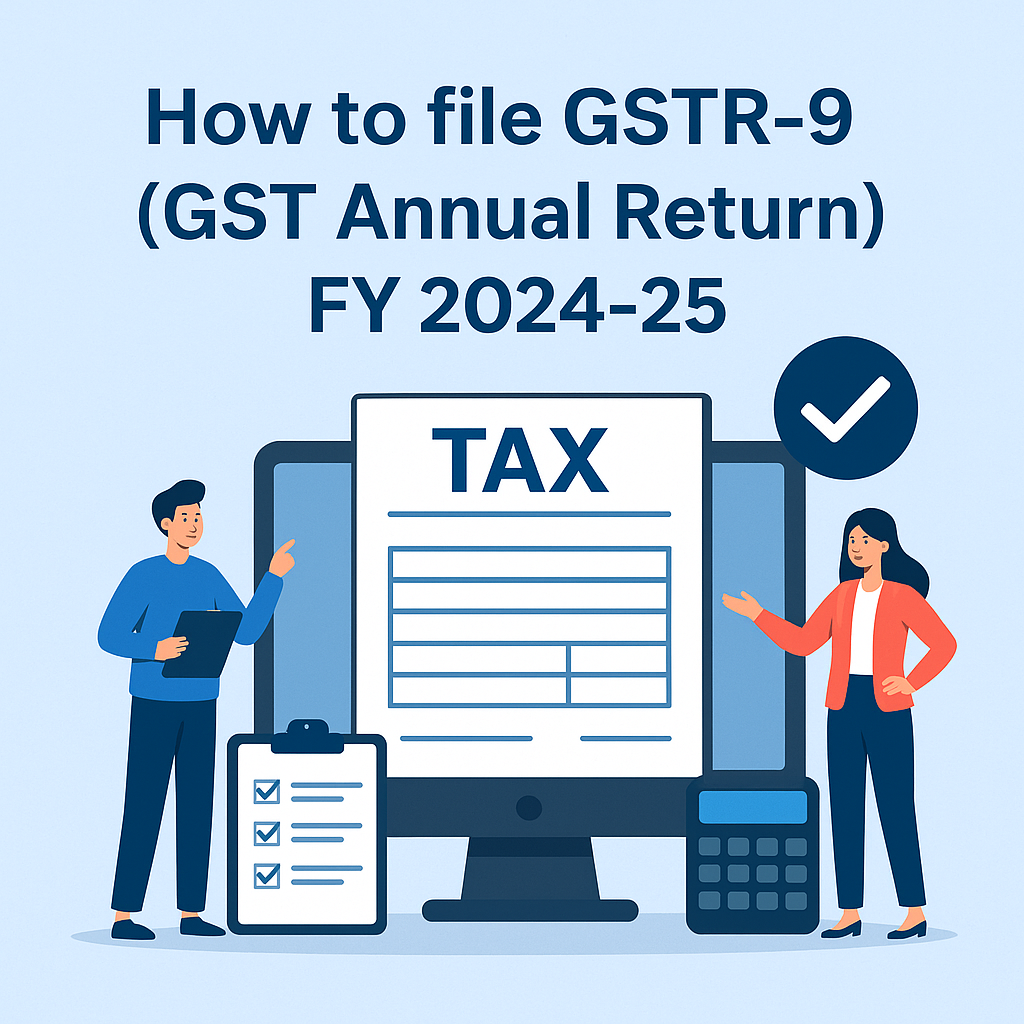✅ Your Complete Guide to Filing the GSTR-9 Annual GST Return for FY 2024-25
GSTR-9 is one of the most crucial annual filings under the Goods and Services Tax (GST) framework. It presents a consolidated summary of a taxpayer’s outward supplies, inward supplies, input tax credit (ITC), taxes paid, and all reconciliations carried out throughout the year. For FY 2024-25, the GST portal has introduced several new validations, reporting updates, and system checks—making accuracy more important than ever for businesses and tax professionals.
This guide covers everything you need to know about GSTR-9, including its purpose, eligibility, due dates, detailed table-wise instructions, new FY 2024-25 changes, common errors, essential checklists, and expert recommendations for smooth and compliant filing.
1. What is GSTR-9?
GSTR-9 is the annual GST return that compiles:
-
The outward supply data reported in GSTR-1
-
Tax liability and ITC information furnished through GSTR-3B
-
Auto-populated details from GSTR-2B
-
Figures drawn from the taxpayer’s books of accounts
This annual summary acts as a comprehensive reconciliation statement and is a critical document during departmental audits, scrutiny reviews, and assessment proceedings.
2. Who Is Required to File GSTR-9?
The following categories of registered persons must file GSTR-9 for FY 2024-25:
-
Regular GST taxpayers
-
SEZ units and developers
-
Businesses with an annual turnover above ₹2 crore
Exempt from filing GSTR-9:
-
Composition taxpayers (who file GSTR-4 instead)
-
Input Service Distributors (ISD)
-
Non-resident taxable persons
-
Casual taxable persons
3. GSTR-9 Due Date for FY 2024-25
The deadline for submitting GSTR-9 for FY 2024-25 is 31st December 2025, unless extended by the government.
Delays can result in substantial late fees under Section 47 of the CGST Act—especially for businesses with higher turnover—making early reconciliation and preparation essential.
4. Key Updates in GSTR-9 for FY 2024-25
For FY 2024-25, the Government has introduced multiple new reporting sections and revised the structure of existing tables in GSTR-9. These updates are designed to strengthen reconciliation across books, GSTR-1, GSTR-3B, and GSTR-2B. They also help capture cross-year ITC movements more accurately and reduce mismatch-based notices.
1. New Table 6A1 – ITC of Earlier Year Claimed in FY 2024-25
Earlier, all ITC availed during the year was clubbed under a single Table 6A.
Now, a separate Table 6A1 has been introduced to disclose:
-
ITC relating to FY 2023-24
-
Claimed during FY 2024-25
-
Except ITC reclaimed under Rule 37 / 37A
This helps distinguish between current-year ITC vs. past-year ITC, improving audit accuracy.
2. Table 6A Split into 6A1 & 6A2
The earlier consolidated Table 6A now has:
-
6A1: ITC pertaining to previous year but claimed now
-
6A2: ITC relating exclusively to FY 2024-25
This split ensures clearer classification and reduces reconciliation errors.
3. Table 8A Revised – Displays Only FY-Specific Data
Table 8A will now show only those invoices that belong to FY 2024-25, even if the supplier reports them late (April–Oct 2025).
This helps avoid:
-
Unwanted mismatches
-
Wrong ITC eligibility assumptions
-
Errors during audit or scrutiny
4. New Table 8H1 – Import ITC Claimed in the Next FY
A new table 8H1 has been added to capture:
-
ITC on imports related to FY 2024-25
-
But claimed in FY 2025-26
This ensures accurate matching with ICEGATE and prevents excess ITC claims.
5. Table 9 Enhanced – Auto-Detects Tax Gaps
Table 9 has been redesigned with:
-
A new field for Total Tax Paid
-
A comparison field showing the difference between tax payable and paid
Any shortfall is flagged as pending liability, which may require payment via DRC-03.
6. Additional Breakups Added in Table 7 – ITC Reversals
Table 7 now separately shows reversals under:
-
Rule 37 (non-payment to supplier)
-
Rule 37A (mismatch-based reversals)
-
Rule 42 & 43 (proportionate & capital goods ITC)
-
Blocked ITC u/s 17(5)
Earlier, these were clubbed together; now they’re clearly segregated.
7. Updated Validations in Tables 10 & 11 – Amendments
Tables 10 & 11 still capture amendments relating to FY 2024-25 reported later, but with stronger validations:
-
Only correct-year amendments allowed
-
Wrong-year reporting will trigger errors or notices
8. Tables 12 & 13 – Tighter Cross-Year ITC Tracking
-
Table 12: ITC of FY 2024-25 reversed in FY 2025-26
-
Table 13: ITC relating to FY 2024-25 claimed in FY 2025-26
This ensures complete traceability of ITC movements across financial years.
9. New Excel Download – HSN-Wise Outward Supply Summary
A downloadable file for HSN-wise details of outward supplies is now available to simplify reporting and reduce manual errors.

